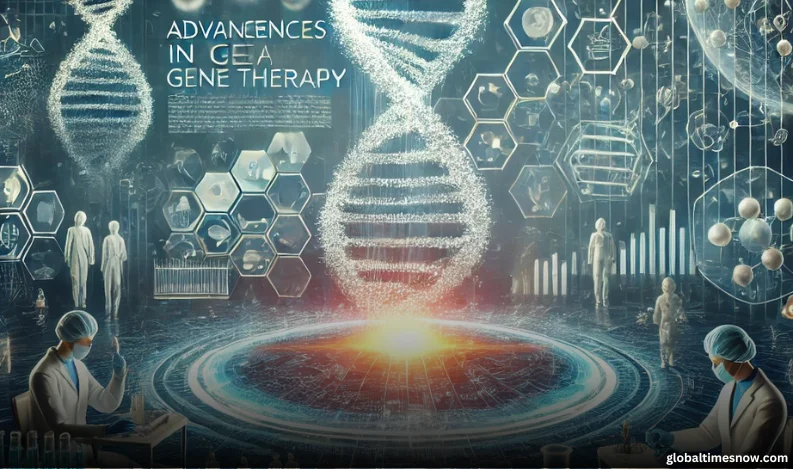Gene therapy has emerged as one of the most promising fields in modern medicine, offering potential cures for previously untreatable genetic disorders. By targeting the underlying genetic causes of diseases, gene therapy seeks to modify, replace, or supplement faulty genes with healthy ones. With rapid advancements in gene-editing technologies, clinical applications are expanding, bringing hope to millions of individuals suffering from genetic conditions. This article explores the latest advancements in gene therapy, its applications, challenges, and the future potential of this revolutionary field.
Understanding Gene Therapy
Gene therapy involves altering the genetic material within a patient’s cells to treat or prevent disease. This can be achieved through different approaches:
-
Gene Replacement Therapy: Involves replacing a faulty gene with a healthy one.
-
Gene Editing: Technologies like CRISPR-Cas9 allow precise modifications of DNA sequences.
-
Gene Silencing: Suppresses the expression of harmful genes.
-
Stem Cell-Based Gene Therapy: Uses genetically modified stem cells to repair or regenerate damaged tissues.
Major Breakthroughs in Gene Therapy
The field of gene therapy has witnessed significant breakthroughs over the past decade. Some of the most notable advancements include:
1. CRISPR-Cas9 Gene Editing Technology
CRISPR-Cas9 has revolutionized gene therapy by enabling precise genome modifications. This technology allows scientists to cut and repair DNA with unprecedented accuracy, making it a powerful tool for treating genetic disorders such as sickle cell anemia and cystic fibrosis.
2. FDA-Approved Gene Therapies
In recent years, regulatory bodies like the U.S. Food and Drug Administration (FDA) have approved several gene therapy treatments:
-
Luxturna (2017): A treatment for inherited retinal disease caused by RPE65 gene mutations.
-
Zolgensma (2019): Used to treat spinal muscular atrophy, a life-threatening genetic disorder in infants.
-
Roctavian (2023): A gene therapy for hemophilia A, significantly reducing the need for clotting factor replacement therapy.
3. Advances in Viral and Non-Viral Delivery Systems
One of the major challenges in gene therapy has been delivering genetic material safely and efficiently into target cells. Recent advancements include:
-
Adeno-Associated Viruses (AAVs): Safer viral vectors with minimal immune response.
-
Lipid Nanoparticles (LNPs): Non-viral delivery systems that have been used successfully in mRNA-based therapies.
-
Electroporation Techniques: Enhance the uptake of genetic material into cells without using viral vectors.
Applications of Gene Therapy
Gene therapy has the potential to treat a wide range of genetic disorders, including:
1. Neurological Disorders
-
Parkinson’s Disease: Gene therapy approaches aim to restore dopamine production in affected brain regions.
-
Huntington’s Disease: Experimental gene silencing techniques are being tested to slow disease progression.
-
Spinal Muscular Atrophy (SMA): Treatments like Zolgensma have dramatically improved survival rates in infants diagnosed with SMA.
2. Blood Disorders
-
Sickle Cell Anemia & Beta-Thalassemia: CRISPR-based therapies have shown promising results in clinical trials, correcting defective hemoglobin genes and reducing symptoms.
-
Hemophilia: Gene therapy treatments like Roctavian provide long-term benefits by enabling the body to produce missing clotting factors.
3. Cancer Treatment
Gene therapy is being explored for cancer treatment through various approaches:
-
CAR-T Cell Therapy: Genetically engineered T cells target and destroy cancer cells.
-
Oncolytic Viruses: Modified viruses selectively infect and kill cancer cells.
-
Tumor Suppressor Gene Therapy: Introduces functional tumor-suppressor genes to inhibit cancer growth.
4. Inherited Retinal Diseases
Gene therapy has shown remarkable success in restoring vision in patients with genetic retinal diseases such as Leber’s Congenital Amaurosis (LCA) and Retinitis Pigmentosa.
Challenges and Ethical Considerations
Despite its potential, gene therapy faces several challenges:
1. Delivery Mechanisms and Safety Concerns
-
Viral vectors can trigger immune responses, leading to adverse effects.
-
Off-target effects in gene editing can cause unintended genetic mutations.
-
Long-term safety data is still limited.
2. High Costs and Accessibility
Gene therapy treatments can cost millions of dollars per patient, making them inaccessible to many. Ensuring affordability and widespread availability remains a significant challenge.
3. Ethical Dilemmas
-
Germline Editing: The modification of embryos raises ethical concerns regarding potential unintended consequences and genetic inequality.
-
Informed Consent: The complexity of gene therapy requires clear communication between researchers and patients to ensure ethical treatment decisions.
-
Potential Misuse: The possibility of using gene therapy for non-therapeutic enhancements (e.g., designer babies) raises bioethical questions.
Future Prospects
The future of gene therapy looks promising with ongoing research and technological advancements. Some exciting developments on the horizon include:
-
Base Editing and Prime Editing: More precise gene-editing techniques with reduced off-target effects.
-
Personalized Gene Therapy: Custom-tailored treatments based on an individual’s genetic makeup.
-
Expanded Applications: Research is exploring gene therapy for conditions like cardiovascular diseases, Alzheimer’s, and metabolic disorders.
-
Lower Costs: Innovations in manufacturing and delivery methods may reduce costs, making gene therapy more accessible worldwide.
Conclusion
Gene therapy is transforming the landscape of modern medicine by offering groundbreaking treatments for genetic disorders. With continued advancements in technology, delivery methods, and ethical frameworks, gene therapy has the potential to provide long-term solutions for previously incurable diseases. While challenges remain, the progress made so far underscores the immense possibilities this field holds for the future of healthcare.
You may also like:-













